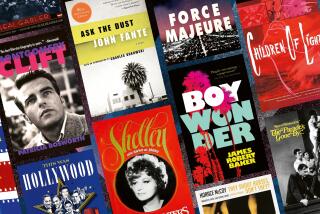Fly the unfriendly skies with âThe Skies Belong to Usâ
Flying used to be fun. Youâd stroll onto an airplane without anyone searching your carry-on luggage. No one scanned your body either. On the plane itself, your kid might get invited into the cockpit, and theyâd serve you Alaskan crab and Champagne â in coach.
And if you were bold enough, you could walk into the cabin with a gun or a fake bomb and insist on being flown to any exotic locale. The compliant airline might even give you a few hundred thousand dollars in cash if you asked for it.
The free-wheeling, hijacking-crazy days of the 1960s and early â70s come to life vividly in Brendan I. Koernerâs evocative new page-turner âThe Skies Belong to Us: Love and Terror in the Golden Age of Hijacking.â With abundant research and a sharp eye for the absurd, Koerner transports us to a time long before anyone thought of crashing planes into buildings, when people took over airplanes for all sorts of weird reasons that were only occasionally political.
Hijacking was an American spectator sport. People commandeered planes for just about any reason â and the media often made them folk heroes. The roguesâ gallery of hijackers included âfrazzled veterans, chronic fabulists, compulsive gamblers, bankrupt businessmen, thwarted academics, career felons and even lovesick teens,â Koerner writes. âEach had an intensely personal, if sadly deluded, rationale for believing they could skyjack their way to better lives.â
Youâd think that a book about the armed takeover of airplanes would make for grim reading. But âThe Skies Belong to Usâ is a lively and often funny account peppered with dumb criminals and feckless officials. In that bygone and more innocent age, the airlines would accede to almost any crazy demand to keep passengers from getting hurt and airplanes from being damaged â though they stubbornly refused to spend the funds and endure the hassle of installing metal detectors at airports.
All that began to change, Koerner argues, thanks in part to one especially colorful pair of young lovers who carried out one of the boldest and most successful takeovers of an airplane in U.S. history.
At first blush, Roger Holder and Cathy Kerkow were a most unlikely pair of hijackers. Holder was an African American Vietnam vet whose war experience left him troubled, adrift and in debt; Kerkow was a white masseuse and small-time drug dealer.
In Koernerâs sensitive and entirely convincing portrayal â drawn from many legal documents, news accounts and interviews â Holder and Kerkow are romantic outcasts. Theyâre in their early 20s, and theyâve admired groups like the Black Panthers and the Weathermen without ever engaging in a political act themselves.
When Holder gets busted for writing fake checks and Kerkow quits her job, they find themselves broke and rootless. After seeing repeated news accounts of hijackings, Holder consults astrology charts (one of several period details Koerner uses to great effect) and chooses a date for what Holder boldly calls âOperation Sisyphus.â He and his girlfriend will hijack a plane with a fake bomb and demand $500,000 and the freedom of Angela Davis, the onetime UCLA professor then on trial in a Northern California courtroom. Then theyâll spirit Davis away to North Vietnam and resettle in the Australian outback and live âhappily ever after,â Koerner writes.
Their plan is hare-brained and half-baked. But they imagine it will work because so many other people have gotten away with even crazier stunts. More importantly, no one is really trying to prevent them from taking over a plane in the first place. For a decade, the airline lobby steadfastly resisted the cost of additional security. The majority of planes hijacked were detoured to Fidel Castroâs Cuba, and for a while it was simply cheaper for the airlines to pay for the extra fuel to fly the planes back home. And even federal officials thought many fliers would rather take the bus than submit to the inconvenience of metal detectors. As the head of the FAA put it in the 1960s: âCan you imagine the line that would form from the ticket counter in Miami if everyone had to submit to police inspections?â
Some 179 planes were hijacked in the U.S. in the decade before Holder and Kerkow took over Western Airlines Flight 701 from San Francisco to Seattle in 1972. In the months preceding their caper, one plane was hijacked by a 14-year-old boy, another by a 74-year-old World War I veteran, and one by an alcoholic used-car dealer wearing shorts and sandals âso that he could hit the beach immediatelyâ after landing in Cuba.
Holder and Kerkow are only slightly better prepared. The bad check they write to buy their tickets bounces before they can make a connecting flight, nearly stopping their hijacking before it gets started. Once in the air, Holder makes a spontaneous and fateful decision that will eventually make their hijacking a record breaker â they will travel farther than any air pirates in U.S. history.
What happens to the couple after their plane reaches its final destination is exciting and dramatic â but their post-hijacking lives quickly become boring and purposeless. But Koerner sticks with Holder and Kerkowâs story for four more decades, finally reaching a conclusion that is at once sad and open-ended.
The media eventually forgot the hijacking lovers. But the impact of their impetuous actions was quick and enduring. Within six months, Americans were standing en masse before airport metal directors for the first time. The press expected passengers to rise in revolt. They did not. Nor would in the decades that followed, as security procedures and devices became increasingly more elaborate.
âThe skyjackers had become so brazen that even the most privacy-conscious travelers had come to accept the need to sacrifice convenience for peace of mind,â Koerner writes. A man and a woman forgotten to history had changed flying forever.
The Skies Belong to Us
Love and Terror in the Golden Age of Hijacking
Brendan I. Koerner
Crown: 336 pp., $26
More to Read
Sign up for our Book Club newsletter
Get the latest news, events and more from the Los Angeles Times Book Club, and help us get L.A. reading and talking.
You may occasionally receive promotional content from the Los Angeles Times.









